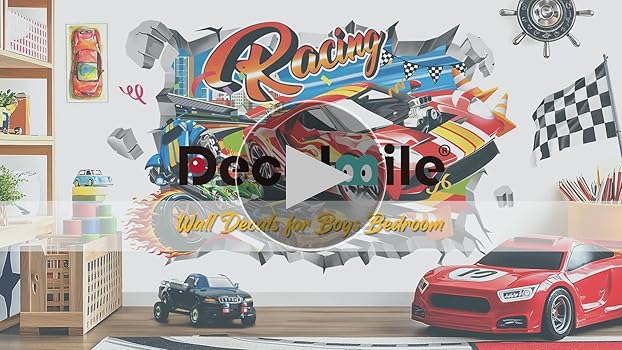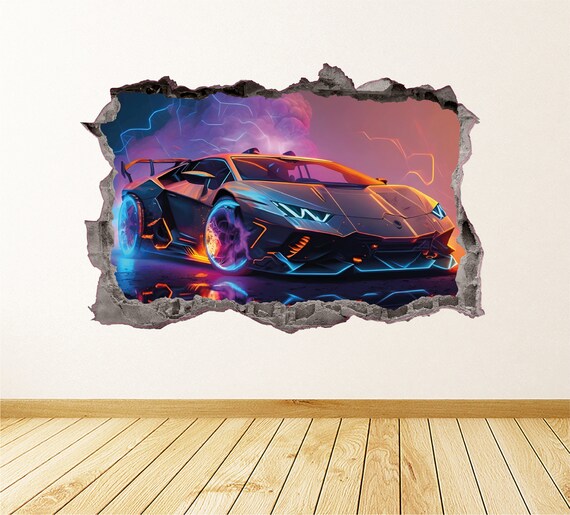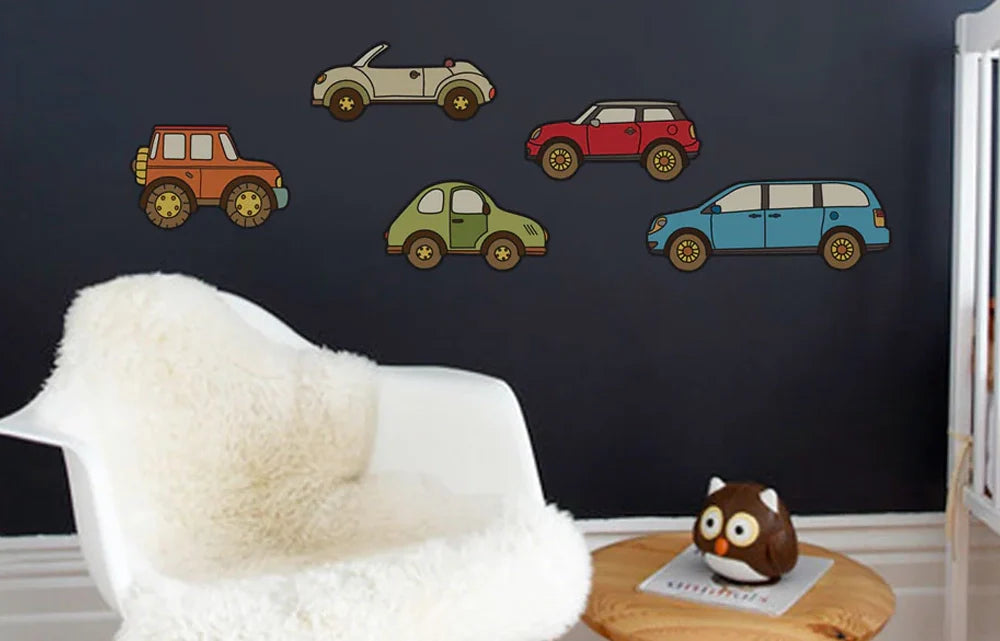Have you ever thought about giving your car a fresh, unique look without spending a lot of money? Wall stickers might seem like a fun and easy option, but can you actually apply them to your car?
If you’re curious about whether these stickers will stick, last, or even damage your car’s surface, you’re in the right place. Keep reading to discover everything you need to know before turning your car into a moving piece of art with wall stickers.
Your car’s new look could be just a sticker away!

Credit: www.notonthehighstreet.com
Car Wall Stickers Basics
Applying wall stickers to your car might sound unusual, but it’s a trend gaining traction among car enthusiasts and casual drivers alike. Understanding the basics of car wall stickers can help you decide if they suit your style and vehicle. Let’s break down what these stickers are and which types work best on car surfaces.
What Are Wall Stickers
Wall stickers are adhesive decals designed to stick on smooth surfaces. They usually feature decorative designs, quotes, or patterns and are easy to apply and remove without damaging the surface underneath.
While traditionally made for walls, some wall stickers can be used on cars if they have the right material and adhesive strength. The key is choosing stickers that won’t peel off or leave residue when exposed to weather and movement.
Types Suitable For Cars
Not all wall stickers work well on vehicles. Here are some types that hold up better on car surfaces:
- Vinyl Stickers:These are durable, weather-resistant, and flexible, making them perfect for cars. They can handle rain, sun, and car washes.
- Static Cling Stickers:These don’t use adhesive but cling to smooth surfaces through static electricity. They’re easy to remove but might not last long outdoors.
- Transparent or Clear Stickers:Designed to blend with the car’s paint, these stickers often use strong adhesive and resist fading.
Choosing the right type can make all the difference between a sticker that lasts and one that quickly peels off. Have you thought about how your car’s surface and exposure to elements might affect sticker durability?
Choosing The Right Sticker
Choosing the right wall sticker for your car is more important than you might think. The wrong sticker can peel off quickly or even damage your car’s paint. It’s not just about picking a cool design—you need to consider both the sticker’s material and its size to ensure it sticks well and looks great over time.
Material Considerations
Not all stickers are made equal. Vinyl stickers are usually the best choice for cars because they are waterproof and resistant to sunlight. Paper-based or thin plastic stickers might look nice at first but often fade or peel within weeks.
Think about where you’ll place the sticker. If it’s on a part of the car that gets a lot of exposure to rain or sun, choose a material with UV protection and strong adhesive. Have you checked if the sticker can handle temperature changes? Some materials shrink or crack in cold weather.
Design And Size Selection
The design should match your car’s style but also fit the space you want to decorate. Large stickers can overwhelm smaller car surfaces, while tiny ones might get lost on bigger panels. Measure the area carefully before buying to avoid surprises.
Complex designs with many colors or small details might not come out clearly on curved surfaces like car doors or bumpers. Simple, bold shapes often look better and last longer. What message or vibe do you want your car to send? That can help you narrow down your design options.
Preparing Your Car Surface
Clean the car surface thoroughly to remove dirt, grease, and dust. Dry it completely to ensure stickers stick well and last longer. Smooth surfaces work best for wall stickers on cars.
Preparing your car surface is essential before applying wall stickers. A clean and smooth surface ensures proper adhesion. This process prevents peeling or bubbling later on. Follow these steps for a perfect surface.Cleaning And Drying
Start by washing the car area where you’ll apply the sticker. Use mild soap and water. Avoid strong detergents that may damage the paint. Rinse thoroughly to remove any soap residue. Dry the surface with a clean, lint-free cloth. Ensure no moisture remains. Moisture can affect the sticker’s adhesive properties. Pay attention to corners and edges.Surface Smoothness Check
Inspect the car surface for smoothness. Look for dents, scratches, or rough areas. These can prevent the sticker from sticking properly. If you find imperfections, consider fixing them. Use sandpaper for rough spots if needed. Ensure the surface is flat and even. This step is crucial for long-lasting adhesion.Applying Wall Stickers On Cars
Applying wall stickers on your car can be a fun and creative way to personalize your ride. However, the process requires careful attention to detail to ensure the stickers stick well and don’t peel off quickly. Understanding how to apply these stickers correctly can save you time and avoid frustration.
Tools You’ll Need
- Wall stickers:Choose vinyl stickers designed for smooth surfaces; avoid paper-based ones.
- Cleaning supplies:Use rubbing alcohol or a mild cleaner and a lint-free cloth to prep the surface.
- Squeegee or credit card:Helps smooth out air bubbles and ensures strong adhesion.
- Masking tape:Useful for positioning the sticker before sticking it down.
- Measuring tape or ruler:To align your sticker perfectly on the car panel.
- Hairdryer or heat gun:Optional but helpful to make the sticker more flexible on curved surfaces.
Step-by-step Application
Start by cleaning the car surface thoroughly. Dirt, grease, or wax can prevent the sticker from sticking properly. Use rubbing alcohol on a cloth and wipe the area until it’s completely clean and dry.
Next, position the sticker on your car without removing the backing. Use masking tape to hold it in place and check the alignment. This step is crucial—once the sticker touches the surface, repositioning becomes difficult.
Carefully peel off the backing paper, exposing the adhesive side. Slowly press the sticker onto the car, starting from one edge. Use a squeegee or a credit card to smooth it out, pushing air bubbles towards the edges.
If your car has curves or uneven surfaces, gently warm the sticker with a hairdryer to make it more flexible. This prevents cracking or peeling later. Avoid overheating; just a few seconds of warmth is enough.
After applying, leave the sticker undisturbed for at least 24 hours to let the adhesive set. Have you ever struggled with a sticker peeling off after a few days? Taking these steps seriously can help you avoid that common problem.
Common Application Mistakes
Applying wall stickers to a car surface may seem simple but comes with common pitfalls. These mistakes can affect the sticker’s look and how long it lasts. Knowing these errors helps avoid frustration and ensures a smooth, clean finish. Two main problems are air bubbles and wrinkles, and peeling edges.
Air Bubbles And Wrinkles
Trapped air causes bubbles under the sticker. They create bumps and spoil the smooth look. Wrinkles happen if the sticker stretches or folds during application. Both issues make the sticker peel faster and look unprofessional.
- Clean the car surface well before applying.
- Apply the sticker slowly, pressing from the center outwards.
- Use a squeegee or a flat tool to smooth out bubbles and wrinkles.
- Work in a dust-free and dry environment.
Peeling Edges
Edges lifting is a common sign of poor adhesion. Dirt, moisture, or uneven surface can cause this. Peeling edges let dirt get under the sticker, reducing its lifespan.
- Make sure the surface is dry and clean.
- Press down edges firmly after application.
- Avoid applying stickers on rough or curved parts.
- Consider using heat from a hairdryer to help the sticker stick better on curves.

Credit: www.amazon.ca
Removing Wall Stickers Safely
Removing wall stickers safely is essential to avoid damaging your surfaces or leaving behind sticky residue. Whether you’re peeling off a decorative sticker from your car window or a wall decal from your room, gentle and thoughtful techniques make all the difference. Let’s look at how you can do this cleanly and effectively without frustration or mess.
Peeling Techniques
Start by loosening one corner of the sticker slowly. If the edge resists, use a plastic card or your fingernail to lift it gently without scratching the surface.
Pull the sticker back at a low angle, almost parallel to the surface. This reduces stress on the adhesive and helps prevent tearing.
If the sticker feels stubborn, warm it slightly with a hairdryer on low heat. Heat softens the glue, making the sticker easier to peel off without leaving bits behind.
Have you ever tried ripping a sticker too quickly and ended up with a sticky mess? Taking your time here saves you cleaning headaches later.
Cleaning Residue
After peeling, some sticky residue might remain. Avoid scrubbing harshly—this can damage paint or glass.
Use a soft cloth dampened with warm soapy water first. Gently rub the area to lift leftover glue.
If soap and water don’t work, try rubbing alcohol or a commercial adhesive remover. Test on a small hidden spot to ensure it doesn’t harm the surface.
Wipe the cleaned area with a dry cloth and let it air dry. This step keeps your surface smooth and ready for a new sticker or just clean and clear.
Caring For Your Car Decals
Caring for your car decals is essential to keep them looking fresh and vibrant. Proper care not only extends the life of your stickers but also protects your car’s paint underneath. Small daily habits can make a big difference in how long your decals stay intact and eye-catching.
Maintenance Tips
Regular cleaning is key to maintaining your car decals. Use a soft cloth with mild soap and water to gently wipe the surface. Avoid harsh chemicals or abrasive sponges that can damage the sticker’s edges or cause fading.
Check your decals often for any peeling or lifting corners. If you spot any, pressing them back down with a clean cloth can prevent further damage. Do you notice your decal collecting dirt in the edges? A soft toothbrush can help you clean those tricky spots without harm.
Weather Protection
Weather plays a huge role in the durability of your car decals. Extreme heat can cause stickers to bubble or peel, while cold weather might make them brittle. Whenever possible, park your car in shaded areas or garages to shield your decals from direct sunlight and harsh elements.
Consider applying a clear protective sealant over your decal to add an extra layer of defense against rain, snow, and UV rays. This small step can keep colors bright and prevent cracking. Have you tried using a car cover during bad weather? It’s a simple way to protect both your decals and your vehicle overall.

Credit: www.etsy.com
Creative Ideas With Car Stickers
Creative ideas with car stickers bring fun and personality to any vehicle. They offer an easy way to change your car’s look without paint or permanent changes. Stickers come in many shapes, sizes, and designs. They can reflect your style, interests, or mood. Applying them smartly can make your car stand out on the road.
Customizing Your Ride
Car stickers let you customize your vehicle quickly and affordably. Use bold colors to make your car pop. Choose patterns like stripes or checkers for a sporty feel. Show your hobbies or favorite quotes with fun decals. Place stickers on windows, bumpers, or doors. Mix and match small stickers for a unique collage. Always clean the surface before applying for best results.
Seasonal And Event Themes
Seasonal car stickers add festive spirit to your ride. Show holiday cheer with Christmas or Halloween decals. Celebrate special events like sports games or birthdays. Temporary stickers make it easy to switch designs often. Use themed stickers for parades or community events. Keep your car fresh and fun throughout the year by changing stickers with the seasons.
Frequently Asked Questions
Can Wall Stickers Damage A Car’s Paint?
Wall stickers are not designed for cars and may damage paint. They can leave adhesive residue and cause peeling when removed. Use car-specific decals for safe application and easy removal without harming your vehicle’s surface.
How Long Do Wall Stickers Last On A Car?
Wall stickers generally last a short time on cars due to weather and movement. They may peel or fade quickly. Car decals are made for durability and last longer under outdoor conditions.
Are Wall Stickers Waterproof For Car Use?
Most wall stickers are not waterproof and may peel off when exposed to rain. Car decals use waterproof materials to withstand moisture and car washes. For outdoor car use, choose waterproof and UV-resistant stickers.
Can You Remove Wall Stickers From A Car Easily?
Removing wall stickers from a car can be difficult and may leave residue. Heat and adhesive removers help but risk paint damage. Car decals are designed for easy, clean removal without harming the paint.
Conclusion
Applying wall stickers to a car can work but needs care. Not all stickers stick well on car paint. Choose stickers made for outdoor use and smooth surfaces. Clean the car surface before applying to avoid bubbles. Removing stickers might leave marks or damage the paint.
Test a small area first to see how it reacts. With the right stickers and care, you can add fun designs to your car. Just remember, wall stickers are not the same as car decals. Take your time and enjoy the process.





